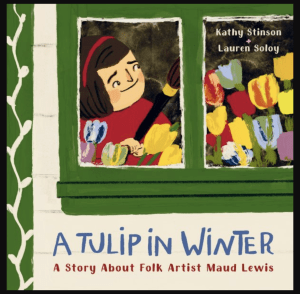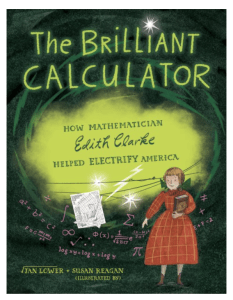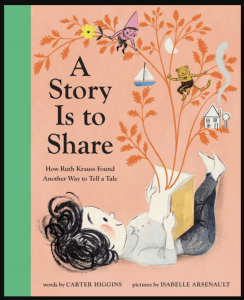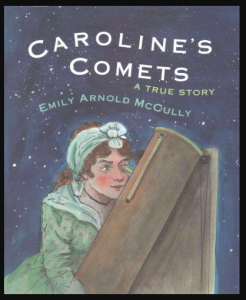Stone, Tanya Lee. Remembering Rosalind Franklin. New York: Christy Ottaviano Books / Little, Brown and Company, 2024.
Who discovered the double helix structure of DNA? James Watson and Francis Crick won a Nobel Prize for the discovery in 1962. But it was Dr. Rosalind Franklin’s work using X-ray diffraction that revealed that double-helix structure of deoxyribonucleic acid. It was her photograph that showed the molecule with the genetic instructions for the development of life. This well-designed 40-page picture book biography by an award-winning writer tells the story of an intelligent and inquisitive scientist who sadly never received recognition during her lifetime. Illustrated by Gretchen Ellen Powers and accompanied by an afterward describing the the historical tendency for women’s achievements to be overlooked, it is highly recommended for inquisitive readers 11 years old and up.
biographies
The Crayon Man
Biebow, Natascha. The Crayon Man. Boston: Houghton Mifflin Harcourt, 2019.
Coloured oil pastel pencils were invented in 1834 by the Staedtler company. Coloured art pencils were invented in 1924 by Faber-Castell and Caran d’Ache. In between those two dates – in 1903 – coloured wax crayons were invented by Edwin Binney, a man who loved colour. Binney had already invented an inexpensive gray slate pencil and a white chalk pencil that wasn’t dusty. He’d invented a wax crayon, but it was black and he wanted colour. So he and a team experimented using ground up rocks and minerals. They tried adding clay and wax. They tried heating the mixtures and letting them slowly cool. Finally, they were ready with a box of eight: blue, brown, green, orange, red, violet, yellow, and – of course – black. Crayola crayons became famous!
Supplemented by a two-page illustrated step-by-step explanation of how crayons are still made in Pennsylvania, a one-page biography of additional information about Binney, and a bibliography for curious readers, this picture book is happily recommended for readers six to eleven years old.
P.S. As a source of information for students doing research to expand their general knowledge, this book is great. As a read-aloud for young children, it will still be interesting but the small boxes of additional information in a smaller font on six of the pages disrupt the flow of the story. I wish that the author had found a way to either include the information in the main text or put it in an appendix. I also wish the designer of the book had chosen a more cheerful font for the story. But otherwise, this is a wonderful biography to encourage readers to be curious about the everyday objects all around them.
A Tulip in Winter
Stinson, Kathy. A Tulip in Winter: A Story About Folk Artist Maud Lewis. Vancouver: Greystone Kids/Greystone Books, 2023.
Sunshine in darkness. Joy in the midst of hardship. The story of the Canadian artist from Nova Scotia has been told many times but never more lyrically than in this engaging picture book. Maud Lewis, born in 1903, developed debilitating rheumatoid arthritis as a child. Despite pain and poverty, she spent her life painting cheerful pictures on furniture, walls, windows, scraps of wood and cardboard, and everything else around her. She died in 1970, having never sold any of her work for more than ten dollars. Today, her paintings sell for tens of thousands of dollars. This beautifully designed picture book – with a cheerful font and full-page illustrations by Lauren Soloy – is highly recommended for anyone who enjoys biographies and appreciates excellent writing.
The Brilliant Calculator
Lower, Jan. The Brilliant Calculator: How Mathematician Edith Clarke Helped Electrify America. New York: Calkins Creek, an imprint of Astra Books for Young Readers, 2023.
Edith Clarke was born in 1883 and grew up loving numbers, excelling at school math competitions. She was sent to boarding school to learn about manners and music but instead dreamed of building railroads and bridges. After attending college, she became a math and physics teacher and helped invent a slide rule to speed up math calculations. She studied engineering, designed electrical transmission lines, and invented a calculator to help other engineers provide electricity for people all across America. All the information is told as a smoothly flowing story, in short sentences comfortable for reading silently or aloud. Extensive additional information is included at the end: an author’s note; a timeline; a glossary; a descriptive list of eight more women mathematicians, engineers, and inventors; and a lengthy bibliography. This beautifully designed and illustrated biography highly recommended for readers 9 to 90 years old.
You know those paper grocery bags and lunch bags? Margaret Eloise Knight invented a machine that could fold and glue paper to make those flat-bottomed bags.
Have you heard of desalination? Maria Telkes invented a device that used solar power to turn salt water into fresh drinkable water.
Every day, there seems to be a new computer software programme. Erna Schneider Hoover received one of the very first patents for computer software, designing a system to prevent telephone networks from becoming overloaded.
A Story is to Share
Higgins, Carter. A Story Is to Share: How Ruth Krauss Found Another Way to Tell a Tale. New York: Abrams Books for Young Readers, 2022.
How do you tell a story with a violin? How do you tell a story with paint? How do you tell a story with words when your ideas scatter all over and tumble away? Ruth Krauss, award-winning author of more than forty children’s books includingThe Carrot Seed, grew up to find a way. This playful picture book, whimsically illustrated by Isabelle Arsenault and accompanied by two pages of background information, is cheerfully recommended for readers 6 to 10 years old. It’s also recommended for writers who are curious about how small changes can affect the tone of a story: Nowhere in this book is Ruth’s name mentioned; not once; instead, the author always refers to her to as ‘the girl’ or ‘she’. How does that affect a reader’s connection to the story?
Ordinary, Extraordinary Jane Austen
Hopkinson, Deborah. Ordinary, Extraordinary Jane Austen. New York: Balzer & Bray, an imprint of HarperCollinsPublishers, 2018.
“Nothing ever fatigues me but doing what I do not like.”
“The real evils, indeed, of Emma’s situation were the power of having rather too much her own way, and a disposition to think a little too well of herself.”
“For what do we live, but to make sport for our neighbors, and laugh at them in our turn.”
“It is a truth universally acknowledged, that a single man in possession of a good fortune, must be in want of a wife.”
Jane Austen was born in England over two hundred years ago. But her novels still entertain people all around the world. This biography tells the story of how she grew up to become a famous writer. The style and size of the text, the detailed ink and watercolour illustrations by Qin Leng, and the layout of the pages all combine to create a delightful picture book highly recommended for curious readers 9 to 15 years old.
A list of classic novels for all ages
Deborah Hopkinson has written many wonderful picture books and novels. You can find more by typing ‘Hopkinson’ into the search box on the right hand side at the top.
The Astronomer Who Questioned Everything
Alary, Laura. The Astronomer Who Questioned Everything: The Story of Maria Mitchell. Toronto: Kids Can Press, 2022.
Two hundred years ago on Nantucket, a little girl grew up with parents who believed both boys and girls should be educated. Her father was a schoolteacher and an astronomer and her mother had been a librarian, so it is not surprising that Maria and her nine siblings were encouraged to learn and think for themselves. Maria, a daydreamer, grew up to become a teacher and a librarian who loved challenges. When the King of Denmark offered a prize to the first person who could find a new comet, Maria determinedly looked through her telescope night after night until she spied a new comet. She won! Now she was famous and was soon invited to be a professor of astronomy. Maria spent the rest of her life encouraging her students to explore the skies and ask questions. Additional biographical information and a bibliography accompany this picture book cheerfully illustrated by Ellen Rooney. Highly recommended for readers 8 to 14 years old who enjoy true stories about historical figures.
P.S. The author’s combination of short and long sentences – and sentence fragments – creates a lovely rhythm for reading aloud. So lovely that it almost seems a shame to read the story silently. But the style of font is unfortunately not so lovely: the print is too serious and too small for the pictures. But that’s a minor fault compared to the beauty of the illustrations and the flow of the words. If you want a happy story that encourages patient persistence, read this book.
Another picture book about an astronomer…
McCully, Emily Arnold. Caroline’s Comets: A True Story. New York: Holiday House, 2017.
Caroline Herschel was born in Germany in 1750. Her father and brothers were musicians but she – being a girl – was kept busy doing housework. Everything changed when she was 22 years old. She joined her older brother in England and became a professional singer and then an assistant to her brother, who had become an astronomer for King George III. Later, she also earned a salary as an astronomer for the king. Before she died in 1848, she had discovered 8 comets and become a star among scientists.
Quotations from Caroline’s diary are embedded in this incredible story of the first woman to discover a comet. The gently old-fashioned pen, ink, and watercolour illustrations enhance this picture book biography for readers 9 years old and up.
More stories about strong female characters







